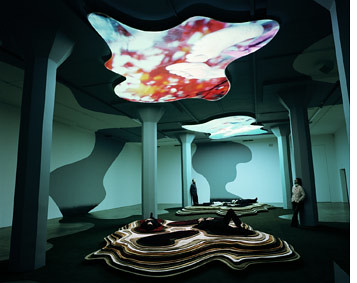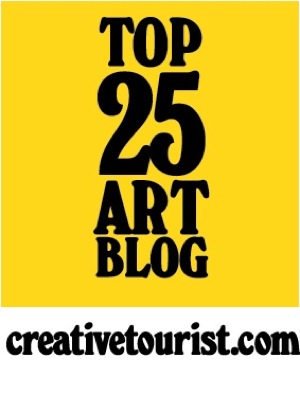
This week, amongst other things, I went on a little trip to Liverpool for a work-related event. The event itself was very interesting, but a little too participatory for my liking (we had to do a tableau at one point. Yes, really).
However, having survived my day of participation, I took myself over to FACT to see the new Pipilotti Rist exhibition, and I think I have now found myself a new favourite media artist.
For me, the highlight of the show was the installation Gravity Be My Friend, which invites viewers to lie down on heaps of soft carpeting, arranged like islands drifting through calm seas, to watch video projections shown on the ceiling. Moving through hazy, Edenic landscapes, to the background of an uncanny lullaby of strings and bells, we glimpse vague mermaid-like figures moving through an underwater haze. The work is rife with dream-like symbolism, but for me, it’s peculiar power lay in its ability to evoke a strange nostalgia for lost childhood summers, and the most elusive early memories, enhanced by a vivid colour palette of apple-red, sky-blue and grass-green.
Your Space Capsule, in Gallery 2, continues the theme of childhood, re-creating the pleasure of miniature dolls-house landscapes. Peering inside what appears to be an ordinary crate abandoned on the gallery floor, we find ourselves looking down into a tiny, private space, perhaps a student flat, complete with books and records scattered on the floor, a plant in a pot and even a tiny pizza in a box. What makes this tiny space unique is that an enormous planet against a cosmic background of stars has literally invaded this intensely personal territory, making an interesting statement about the relationship of the particular and universal, the individual and the eternal, the miniature fragments of space we occupy and the broad horizons we can fathom. Meanwhile, Apple Tree Innocent on Diamond Hill dangles a variety of clear plastic packaging from the branch of a tree, transforming everyday domestic objects into twinkling, transluscent objéts d’art, seemingly endowed with a strange, almost magical power, as if a part of some secret ritual or unknown child's game.
Writing for The Guardian here, Adrian Searle complains that this exhibition “sometimes makes me feel as if I'm stuck inside a vegan, possibly even fructarian, new-age indoctrination video” and even compares Gravity Be My Friend to a hair conditioner ad. I can see where he’s coming from - there’s no doubt that Rist’s interest in 1960s art and culture and utopian idealism infiltrate these works, and yes, there might even be a Timotei moment or two. But there is a strong sense of humour implicit behind this throughout all of Rist’s work: an enjoyable, infectious “silliness” which Searle himself acknowledges. This is perhaps most obviously embodied in her 1997 video Energy Is Over All, which is perhaps the best-known work in the show, and clearly reveals the artist’s infectious, anarchic good humour. Here, a woman in a flirty, floaty summer dress dances blithely down a city street, pausing every now and again to smash the window of a parked car with the long-stemmed flower she carries. These unexpected acts of violence are seemingly tolerated by a friendly policewoman, who becomes almost a co-conspirator in the act itself. Of course, I noticed that the woman is wearing red shoes: it’s no surprise to read that feminist theorist and writer Peggy Phelan has suggested that she acts as a parallel Dorothy figure, skipping merrily in her ruby slippers down a modern-day urban yellow brick road.
For me, it’s precisely this sense of energy, irreverence and playfulness which makes these works so enjoyable and engaging, particularly in contrast to some media artworks where technology serves to keep us, as viewers, distanced and unable to access meaning, firmly at arms length. Instead, Rist seems to find a child-like delight in the magic, the sheer imaginative power and the possibility for aesthetic beauty offered by moving image as an artistic form; she gleefully welcomes us to join in the game, to play in her own carefully-constructed fantasy wonderland, as in the installation The Room which physically throws us back into childhood. This sense is, of course, reinforced by the knowledge that the artist’s name ‘Pipilotti’ is a fusion of her own childhood nickname, and the heroine of her favourite children’s book, Pippi Longstocking, giving a clear indication of the enormous importance of play, childlike imagination and innocence at the heart of Rist’s artistic practice. It’s perhaps for this reason that in concluding his review of the show, Searle describes Rist’s work as “a guilty sort of pleasure”, but for me, it’s far less complicated: it’s absolutely this kind of sheer joy and enjoyment which is exactly what the art I like best is all about.
[Image via flickr]















2 comments:
Catherine, I looked for you at the reading night, were you there? I had my eyes peeled for your Clueless clobber...
Oops. Touche. Katherine. x
Post a Comment